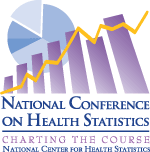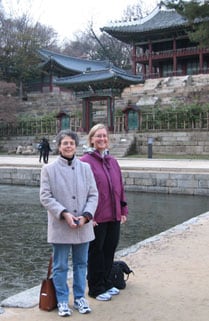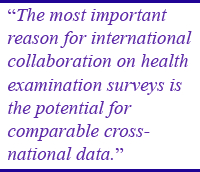
Slides of NHANES Stakeholders Consortium Meetings Now Online
After a long interval, the NHANES Consortium Meetings were held again this year on April 7th with federal collaborators, and on May 4th with other stakeholders. Both meetings generated substantial interest and participation, and the requests for attending live web conferencing surpassed our allotted seats. At this point, all CDC Web Conferencing is limited to 50 seats (audio phone lines), so we offer our sincere apologies to those whom we could not accommodate on May 4th. We also regret that, due to technical difficulties, we could not provide recordings of the meetings as we planned, but all presentation slides are available online. Please visit the 2010 NHANES Stakeholders Consortium Presentations page to view the presentations at your convenience.
What's New on the Web
Browse the latest searchable bibliography: NHANES literature review made easy!
The NHANES Selected Bibliography contains published journal articles, government reports and the latest tables and figures authored, co-authored or reviewed by NCHS staff. The bibliography is organized into topics based on continuous NHANES data (1999 to present). Click the topics in the tree to drill-down to a desired topic and display the list of publications pertaining to that topic. Then, to view the publication or its PubMed abstract, click its hyperlinked title.
Find NHANES statistics quickly using our new Key Statistics feature
Use the topic tree to find summary statistics for a variety of health topics. For more detailed information, click the hyperlinked Source to view the source article or report. Then, you can easily share the statistic and link to the source document with a colleague using either email or Twitter.
NHANES Environmental Chemical Data Tutorial on-line this Summer
The first course of the Environmental Chemical Data Tutorial was published this month. It is an overview of the environmental chemical data, which describes the contents and structure of the data, the limit of detection and multi-year issues, and the use of subsample weights. Upcoming courses in this tutorial include:
- Preparing an Environmental Analytic Dataset,
- Critical Issues for the Analysis of Environmental Chemical Data, and
- Environmental Chemical Data Analyses.
These courses will be posted before the 2010 National Conference on Health Statistics in August, and a hands-on workshop will be presented on the first day of the conference.
Register Now: 2010 National Conference on Health Statistics
Date: August 16-18, 2010
Place: Omni Shoreham Hotel, Washington, DC
A friendly reminder: the conference is FREE, but you do have to REGISTER in order to attend. Register now for the hands-on workshops you want; if it is full, put yourself on the wait list because spaces may become available.
 Better known as the Data Users Conference (DUC) in previous years, this biannual conference drew hundreds of data users to Washington D.C. in the middle of the summer. This year, DUC is taking a whole new look and feel. It is being transformed into the National Conference on Health Statistics. According to the planning committee, this year’s conference “will draw on research topics affecting health-related activities today and will serve as a forum for addressing future health topics. The new conference format has been designed to attract the most knowledgeable and influential professionals in the area of health. Thomas R. Frieden, M.D., M.P.H., Director of CDC, Robert Groves, Ph.D., Director of the U.S. Census Bureau, and Michael Wolfson, Ph.D., Assistant Chief Statistician (recently retired) of Statistics Canada, will address the conference, along with many other esteemed speakers. The 3-day event is shaping up to secure NCHS’ position as a premiere statistical and government agency. This year also promises to be particularly exciting because NCHS will be celebrating 50 years as a statistical agency. We’re planning a number of activities that highlight and celebrate our accomplishments over the past 50 years.”
Better known as the Data Users Conference (DUC) in previous years, this biannual conference drew hundreds of data users to Washington D.C. in the middle of the summer. This year, DUC is taking a whole new look and feel. It is being transformed into the National Conference on Health Statistics. According to the planning committee, this year’s conference “will draw on research topics affecting health-related activities today and will serve as a forum for addressing future health topics. The new conference format has been designed to attract the most knowledgeable and influential professionals in the area of health. Thomas R. Frieden, M.D., M.P.H., Director of CDC, Robert Groves, Ph.D., Director of the U.S. Census Bureau, and Michael Wolfson, Ph.D., Assistant Chief Statistician (recently retired) of Statistics Canada, will address the conference, along with many other esteemed speakers. The 3-day event is shaping up to secure NCHS’ position as a premiere statistical and government agency. This year also promises to be particularly exciting because NCHS will be celebrating 50 years as a statistical agency. We’re planning a number of activities that highlight and celebrate our accomplishments over the past 50 years.”
In addition, there are still some conventional programs and Data Users’ favorite sessions planned for the conference. DHANES will host an overview session to bring you all the changes and updates; and our USDA collaborators will be back for a third time with their popular hands-on workshop – What We Eat in America. Last but not least, the Environmental Chemical Data Tutorial will be debuted at the conference.
So you could see that this is not a just a conference with a new title, but a whole lot of exciting contents waiting to be explored! To register or learn more about the conference, please visit the National Conference on Health Statistics website.
Journey to South Korea:
DHANES Role in International Examination Surveys

Drs. Rosemarie Hirsh (left) and Kathryn Porter (right) visiting the Changgyeonggung Palace Ponds (Joseon Dynasty).
The desire to conduct health examination surveys has been increasing in different parts of the world, especially in the last decade. DHANES staff have played a significant consultative role in many of these efforts. In the late 1990’s, DHANES division director and staff were involved in the planning of nutrition surveys in New Zealand and Australia, resulting in many of the NHANES nutrition measures successfully adopted in each of these countries. Brazil, Kuwait, South Africa, Israel, United Kingdom and France have also requested advice and consultation from DHANES. The most recent collaboration is with the European Union (EU), which is planning examination surveys in all EU countries in the next decade. DHANES is sharing the best practices with EU public health experts in planning and conducting such a survey.
DHANES has also been actively involved in the planning and execution of health examination surveys in South Korea and Canada. In fact, several staff members are providing continuous support and advice to these two national surveys modeled after NHANES. After a recent trip to South Korea, Dr. Rosemarie Hirsch and Dr. Kathryn Porter were interviewed by the NHANES E-Newsletter. Below are the highlights of the conversation.
Q: What was the purpose of your recent trip to South Korea?
 Dr. Hirsch: We were there to share information on several issues. First, we presented how the US NHANES data were used for public health policy and programs; second, we discussed ways our collaborators participate at various stages of the survey; and third, we shared experience and best practices on the planning and operation side of the survey. One example we gave on cotinine really got their attention. In South Korea, stroke and heart disease are common, and they have a pretty large number of smokers. They were fascinated by how NHANES data has been used to assess the magnitude of the problem of second hand smoke and the effectiveness of smoking laws to prevent second hand smoke. From that example, they got to see how their data can be used for formulating and monitoring policy and programs. We also shared our experience on how collaborators contribute to the survey in multiple ways: some with funding for components at the planning stage, some conducting lab tests during data collection, while others provide expertise in data processing and analysis. Our Korean colleagues were interested in how we formed inter-governmental partnerships and collaborations, and our presentation gave them plenty of ideas for possibilities.
Dr. Hirsch: We were there to share information on several issues. First, we presented how the US NHANES data were used for public health policy and programs; second, we discussed ways our collaborators participate at various stages of the survey; and third, we shared experience and best practices on the planning and operation side of the survey. One example we gave on cotinine really got their attention. In South Korea, stroke and heart disease are common, and they have a pretty large number of smokers. They were fascinated by how NHANES data has been used to assess the magnitude of the problem of second hand smoke and the effectiveness of smoking laws to prevent second hand smoke. From that example, they got to see how their data can be used for formulating and monitoring policy and programs. We also shared our experience on how collaborators contribute to the survey in multiple ways: some with funding for components at the planning stage, some conducting lab tests during data collection, while others provide expertise in data processing and analysis. Our Korean colleagues were interested in how we formed inter-governmental partnerships and collaborations, and our presentation gave them plenty of ideas for possibilities.
Dr. Porter: Despite geographic, cultural, and language difference with the U.S., the Korean Centers for Disease Control (CDC) faces the same issues in fielding a large scale heath examination survey. We provided information on methods used to obtain high respondent cooperation rates, how we conduct our data quality assurance and quality control, and how we release public use data sets on an ongoing basis. The Koreans were interested in how NHANES could collect 120 mL of blood from adults in the survey, since their protocol only allows for 15 mL of blood to be collected. NHANES phlebotomy response rates are over 90%, and the investigators in Korea may add more laboratory tests, since high blood volumes could be drawn from their population.
Q: How do these activities fit with the NHANES mission and activities? What is the significance of our involvement in this type of work?
Dr. Hirsch: Both CDC and NCHS have a global health mission and presence, so these activities align with our agency mission. The most important reason for international collaboration on health examination surveys is the potential for comparable cross-national data. Many times when we see differences in disease prevalence estimates between countries, it’s hard to tell whether it may be due to methodological variations in collecting the data. If several countries are collecting data based on very similar protocols, we are getting closer to making some meaningful comparisons. That would allow better assessment of critical public health issues at a global level. Collaborations like these also offer many opportunities for us to learn from our collaborators. For instance, we’ve learned from our Canadian colleagues how to outfit the survey examination trailers for subzero conditions, so we don’t have to avoid northern regions in our sample for the winter season in the future.
Dr. Porter: The NHANES program has 50 years of field experience that health examination surveys conducted by other countries can benefit from. Conversely, we came back with new ideas for “thank you” gifts to NHANES respondents. The Korean CDC gives out a complimentary toothbrush, toothpaste, and a tongue scraper in a nice kit with oral hygiene tips to each participant who completes their Youth Risk Behavior Survey.
Q: What was your impression of South Korea?
Dr. Hirsch: I absolutely adored the food there! And the people were extremely polite and gracious. I’m not just talking about our CDC colleagues in Korea, but people in the shops or at the airport – they were so hospitable! One thing that struck me as amazing was the parking garages. The space was so tight, people had to double park. They just left their cars in neutral so the double parked cars could be moved out of the way. Image that in the U.S.!
Dr. Porter: The South Koreans are hard working people who take great pride in their flagship businesses such as LG, Samsung and Hyundai. The influence of technology is everywhere, from large LCD displays on city buildings to a courtesy cell phone provided with each hotel room at the Hotel Lotte. My favorite thing was seeing the fish swim in large water tanks outside of many restaurants. Now that is fresh fish!